With Resident Evil 8 officially on the way as a next-gen exclusive, fans can look forward to the next numbered entry in the Resident Evil series. But what does that actually mean? As any fan knows, a number does not designate importance, and, to be exact, Resident Evil 8 is actually the 27th Resident Evil game.
Resident Evil 8 may have a nifty number in its title, but numbers mean little in identifying an entry's significance to the canon. For instance, Resident Evil: Code Veronica is much more of a sequel to Resident Evil 2 than Resident Evil 3. Resident Evil 3 occurs parallel to Resident Evil 2, showing players the Raccoon City incident from the perspective of Jill Valentine. Code Veronica, however, actively pushes the story of both Resident Evil and Resident Evil 2 forward. The game follows the exploits of Claire and her brother Chris (the former being the co-protagonist of RE2 and the latter co-staring in the original RE) after the Raccoon City incident. The narrative reveals the fate of Umbrella and reintroduces the villain Albert Wesker, whose involvement in the story sets up his role in Resident Evil 4. Code Veronica pushes the Resident Evil timeline forward into the next sequel, whereas Resident Evil 3 functions as a side story, yet the latter contains a number. Numbers, it seems, cannot be trusted.
27 may be the total number of Resident Evil games, but that number contains remakes and strange aberrations, like the officially non-canon GameBoy Color game, Resident Evil: Gaiden. So, including numbered entries and Code: Veroncia – what some fans might call “the main games” – there are 10 Resident Evil games to account for in the series chronology. However, this is still inadequate, as many of the Resident Evil spin-offs contain significant story beats.
Resident Evil Spin-Off Games Still Count
Resident Revelations and its follow up Resident Evil Revelations 2 are technically spin-offs, but each game involves core characters and deepens the series mythology, especially Revelations 2. That game not only continues Claire's story and brings back fan-favorite Barry Burton, but it also reveals some of the history behind Albert Wesker by introducing his sister Alex Wesker. Mentioned briefly in Resident Evil 5, Alex serves as the primary villain of Resident Evil Revelations 2 and provides series veterans with further information about the “Wesker Children”: a series of experiments aimed at creating super-humans.
Even obscure Resident Evil titles contain canonical details. Umbrella Chronicles and Darkside Chronicles, both originally released on the Wii, are light-gun re-tellings of some of the series' most popular mainline entries. They seem insignificant, but each contains important information. Umbrella Chronicles offers a narration by Albert Wesker that fluidly connects the stories of Resident Evil, Resident Evil 3, and Resident Evil 0, and Darkside Chronicles includes a prequel story to Resident Evil 4 – explaining the past relationship between Jack Krauser and Leon Kennedy as well as detailing how Krauser eventually became Leon's nemesis.
Sure, there are games that clearly aren't canon, like the aforementioned Gameboy Color game, but Resident Evil developers seems content to continue to play with and explore their world, which is now over 20 years in the making, in a multitude of various ways. The advertising heads at Capcom even seem aware of this, considering Resident Evil 8: Village is the first numbered title to sport an extra epithet, excluding the redundancy of Resident Evil 7: Biohazard. In this way, the game melds two worlds. the spin-offs and the numbered entries, and reiterates the wacky tradition that unites the series.


